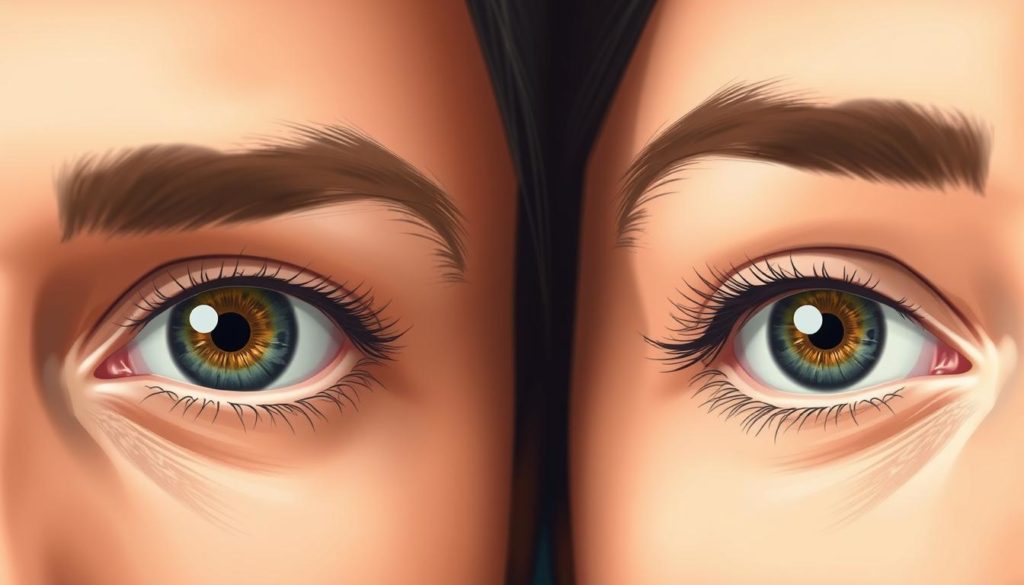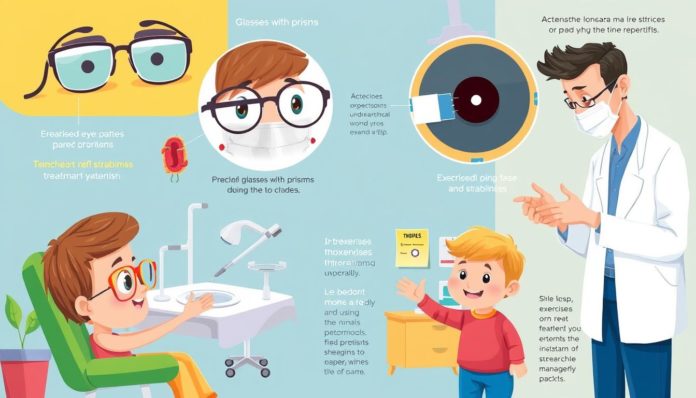Did you know strabismus, or crossed eyes, affects up to 4% of Americans? It’s often seen in young children but can happen at any age. This condition can really change how you see the world and your quality of life. We’ll look into what strabismus is, why it happens, and how it can be treated.
Strabismus is more than just a cosmetic issue. It can mess with your depth perception and make everyday tasks harder. It can even affect how you interact with others. By understanding strabismus and the right treatments, people can improve their vision and overall health. Let’s explore how to manage and treat strabismus effectively.
What Is Strabismus?
Understanding what is strabismus means knowing it’s a condition where the eyes don’t line up right. This can make it look like one eye is pointing in a different direction than the other. It’s especially noticeable when trying to focus on something.

Strabismus Definition
Simply put, strabismus is when one eye looks in a different direction than the other. This can happen in several ways:
- One eye turns inward (esotropia).
- One eye turns outward (exotropia).
- One eye turns upward (hypertropia).
- One eye turns downward (hypotropia).
This misalignment can mess with how we see depth and make it hard to use both eyes together.
Different Types of Strabismus
The various types of strabismus depend on how the eyes are misaligned:
- Esotropia: The eye turns inward.
- Exotropia: The eye turns outward.
- Hypertropia: The eye turns upward.
- Hypotropia: The eye turns downward.
Each type has its own problems and affects how we see and do everyday things. Finding and treating it early is key to lessening these issues.
Recognizing the Symptoms of Strabismus
It’s important to know the symptoms of Strabismus early. This is true for both children and adults. Spotting these signs is the first step to treating the condition.

Common Signs in Children
Strabismus in children shows in clear ways. Parents or caregivers can easily notice these signs. Some common signs include:
- Eyes that appear misaligned or not working together
- Squinting or closing one eye to see better
- Tilted head when looking at objects
- Inconsistent eye movements
- Complaints of double vision or eye strain
Symptoms Observed in Adults
Adult Strabismus has more subtle signs. Yet, they can still affect daily life. Adults should watch for these signs:
- Double vision or ghost images
- Eyes that don’t appear to move in unison
- Eye strain or fatigue
- Difficulty with depth perception
- Frequent headaches or migraines
Knowing these symptoms of Strabismus helps get timely medical help. This ensures the right treatment is started.
Causes of Strabismus
Strabismus has many causes. Knowing these can help prevent and catch it early. Let’s explore the genetic and environmental factors that lead to strabismus.
Genetic Factors
Hereditary Strabismus is a big part of this condition. Family history is key. Kids with a family history of strabismus are more likely to have it.
Genetic changes in eye muscles and nerves can cause misalignment. So, understanding the genetic side is important for early action.
Environmental Influences
Genetics aren’t the only thing that matters. Environmental factors also play a role. Premature birth, cerebral palsy, or head trauma can increase the risk.
Diseases like hyperopia (farsightedness) can also start strabismus. Parents should watch out for these environmental factors to lower the risk.
Diagnosing Strabismus
To diagnose Strabismus, a detailed evaluation is needed. This starts with eye exams and may include special tools for a precise diagnosis.
Initial Eye Examinations
The first step is often a routine ophthalmic exam. Pediatricians and general practitioners use basic vision screening tests. These tests check for eye alignment and movement.
- Observing eye movements
- Checking for symmetrical eye positioning
- Using a cover test to see how the eyes respond individually
Advanced Diagnostic Tools
For deeper checks, an ophthalmologist might use advanced tools. These include:
- Prism and cover tests to measure the degree of eye misalignment
- Corneal light reflex testing to detect precise abnormalities
- Detailed retinal exams to uncover any underlying issues affecting eye alignment
These tools help the ophthalmologist diagnose Strabismus correctly. They then suggest the best treatments.
Strabismus Treatment Options
There are many ways to treat strabismus, each one suited to the person’s needs. Some methods are non-invasive, while others might need surgery. Knowing about these options helps patients and their families make better choices.
Non-Surgical Treatments
Non-surgical treatments aim to fix eye alignment and coordination without surgery. They include:
- Corrective Eyewear: Special glasses or contact lenses can help align the eyes, especially for those with refractive errors.
- Vision Therapy: A structured program of visual activities designed to improve eye coordination and focusing skills.
- Eye Patching: Covering the dominant eye to strengthen the weaker eye, often used for children.
- Prism Lenses: Eyeglasses with prisms can help reduce double vision by realigning the light entering the eyes.
Strabismus Surgery
When other treatments don’t work, strabismus surgery might be needed. This surgery adjusts the muscles around the eyes to improve alignment. It’s usually suggested when other treatments haven’t worked well enough.
Strabismus surgery can greatly improve vision and appearance. Recovery involves follow-up visits and possibly more vision therapy to keep improving.
Strabismus in Children
Early detection and action are key when dealing with strabismus in kids. This early care can greatly improve vision and prevent future problems.
Early Detection and Intervention
Early treatment of strabismus can fix vision issues before they get worse. Regular eye checks and quick action by eye doctors are very important. Early detection means treatments work better, sometimes avoiding surgery.
Here’s how early or late treatment affects outcomes:
| Intervention Timing | Potential Outcomes |
|---|---|
| Early Intervention | High rate of successful correction, minimal long-term issues. |
| Late Intervention | Increased risk of persistent vision problems, possible need for surgery. |
Regular eye exams are vital in Pediatric Eye Care. They help catch strabismus early and treat it quickly. Parents and caregivers should watch for vision problems and get help if they see anything odd.
Living with Strabismus
Living with Strabismus can be tough, both socially and emotionally. It’s important to understand these challenges and find ways to deal with them. This helps keep life positive and fulfilling.
Social and Emotional Impact
People with Strabismus often face wrong beliefs and stigma. This can hurt their self-esteem and make socializing hard. Emotional support for Strabismus is vital to fight feelings of loneliness and boost confidence. Talking openly and spreading awareness can help others understand and be more empathetic.
Adaptive Strategies
There are many ways to cope with Strabismus. Using vision therapy, wearing glasses, and doing eye exercises are good steps. Also, getting emotional support for Strabismus through counseling and groups can help a lot. Creating a daily routine with these activities can make life feel more normal and in control.
Here are some tips for managing Strabismus:
- Go to eye exams regularly and follow your treatment plan.
- Join community or online support groups for emotional support and shared experiences.
- Speak up for yourself at school or work to get the help you need.
By using these strategies, people can live more comfortably and confidently. This makes life full and rewarding, even with Strabismus challenges.
Exploring Strabismus Exercises
Strabismus exercises are key in vision rehab. They help improve eye coordination and alignment without surgery. These exercises strengthen eye muscles and boost vision, making them a great addition to other treatments.
Doing these exercises at home or with a pro can help manage strabismus well. They are a big part of the solution.
Home-Based Eye Exercises
Eye exercises at home are easy and handy. Try focusing on a moving object, like a pencil, or pencil push-ups. Visual tracking exercises also help.
Doing these exercises every day can slowly improve your eyes. But, always follow a doctor’s advice to do them right and safely.
Professional Guidance for Effective Results
While home exercises are good, seeing a pro is even better. An orthoptist or vision therapist can create a plan just for you. They use special exercises and techniques to meet your needs.
A specialist can check your progress and adjust the plan as needed. This ensures you get the most out of your exercises. So, getting professional help is crucial for the best results.
FAQ
What is Strabismus?
Strabismus, also known as crossed eyes, is when your eyes don’t line up right. One eye might look straight, while the other turns in, out, up, or down.
What causes Strabismus?
Strabismus can come from genes, muscle or nerve problems, or injuries. Some diseases in the brain can also cause it. Sometimes, we don’t know why it happens.
What are the symptoms of Strabismus?
Signs of Strabismus include eyes that don’t seem to match, seeing double, and trouble judging depth. You might squint or close one eye to see better. These signs can be different for kids and adults.
How is Strabismus diagnosed?
Doctors use eye exams and tests to find Strabismus. They check your vision and use special tools to see how your eyes move.
What treatment options are available for Strabismus?
Treatments include glasses, vision therapy, and eye patches. Surgery is also used for more serious cases to fix eye alignment.
Is Strabismus common in children?
Yes, kids often get Strabismus. Finding and treating it early is key to avoiding vision problems later on.
What are the social and emotional impacts of living with Strabismus?
Strabismus can hurt your self-esteem and how you interact with others. Support from loved ones and counselors can help. Using strategies to cope can also make a difference.
Are there exercises that can help with Strabismus?
Yes, there are exercises like eye workouts at home and orthoptic therapy. These can strengthen your eye muscles. Getting help from a professional ensures they work well.


